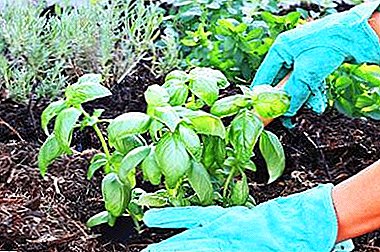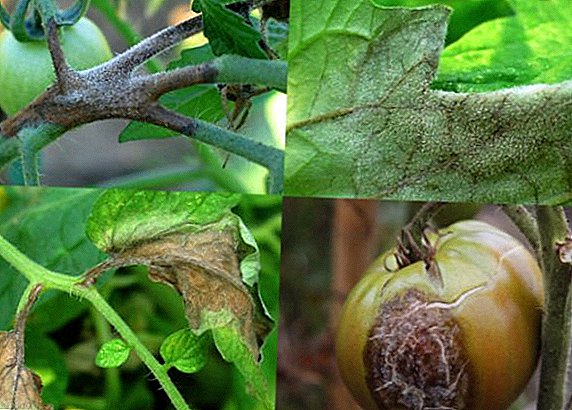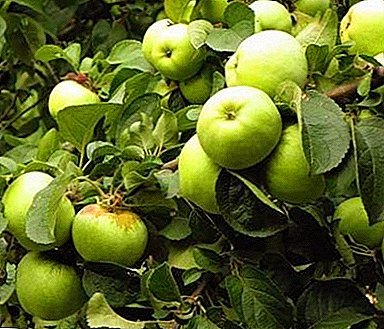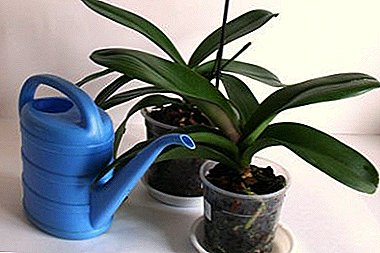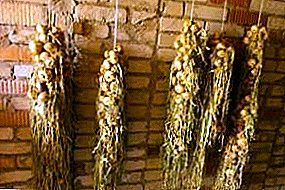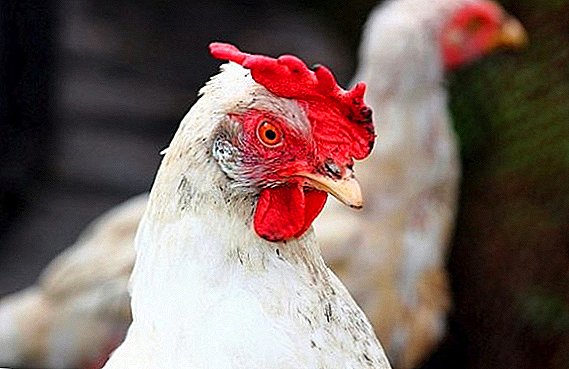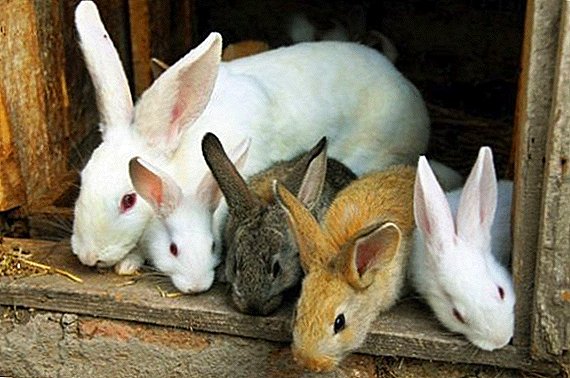 Today, rabbit breeding is one of the most actively developing agricultural sectors. Every year, thousands of farmers re-qualify for professional rabbit breeders, as this trend is not only high payback, but also stable profit.
Today, rabbit breeding is one of the most actively developing agricultural sectors. Every year, thousands of farmers re-qualify for professional rabbit breeders, as this trend is not only high payback, but also stable profit.
But, despite the widespread distribution, this occupation becomes a real challenge for many, since not everyone can create decent conditions for the fur-bearing animal.
In this article, we take a detailed look at the basic principles of keeping rabbits at home, as well as learn about the main secrets of a successful rabbit breeding.
Rabbit maintenance hygiene depending on the system
Modern rabbit producers know several approaches to the maintenance of industrial breeds of rabbits. Often, they are closely related to the type of housing system, and therefore provide animals with radically different conditions. However, not every system is expedient in each individual case; therefore, we will further learn in detail about their basic principles and requirements.
Did you know? Rabbits have no sweat glands on their bodies. - heat exchange with the environment in these animals is due to the pads.
Shadovaya
Shedding system of keeping animals is the most popular in the world. Often it is used on medium and large livestock farms, since the construction of sheds for small farms is not always justified.  Such a system makes it possible to actively breed rabbits in almost all climatic regions, where the average daily minimum does not fall below -30 ° C. Shed is a small elongated room made of wood, reinforced concrete or metal. On both sides of it, in several tiers, there are individual cages with animals.
Such a system makes it possible to actively breed rabbits in almost all climatic regions, where the average daily minimum does not fall below -30 ° C. Shed is a small elongated room made of wood, reinforced concrete or metal. On both sides of it, in several tiers, there are individual cages with animals.
This design perfectly protects animals from rain, snow and wind, as well as from drafts and direct sunlight - this creates an optimal microclimate for favorable growth and development of rabbits. The temperature optimum in such a room is within + 12-18 ° С, while the daily temperature fluctuations are minimal.
You will probably be interested in reading about how to make a shed for a rabbit with your own hands.
Also here an optimum level of humidity is reached, which is in the range of 60-70%. Often, such structures are equipped with artificial lighting, which contributes to the creation of the required length of daylight hours (8-10 hours).  General view of the shed Each cell in the shed is equipped with an individual non-waste feeder and drinker, which often work in automatic mode. Also, rabbits in such a dwelling are provided with a system of removal of feces into special pallets on the lower tier, which protects them from all sorts of infectious diseases.
General view of the shed Each cell in the shed is equipped with an individual non-waste feeder and drinker, which often work in automatic mode. Also, rabbits in such a dwelling are provided with a system of removal of feces into special pallets on the lower tier, which protects them from all sorts of infectious diseases.
To control the humidity of the room, they are equipped with an air ventilation system consisting of opposite through holes with a mechanical gate.
Get acquainted with the diseases of rabbits, methods of their treatment and prevention.
Shed care is quite simple:
- The most important thing in the maintenance of this design is regular cleaning of drains and the central pallet from faeces. They often carry out the procedure manually, using a garden spade and special scraper tools. Wastewaters are also cleaned, as they may accumulate leftover feces. After eliminating the bulk of the place of accumulation of vital waste, if possible, wash it out with running water and treat with disinfecting solutions (4% formalin solution, 3% copper sulfate solution).
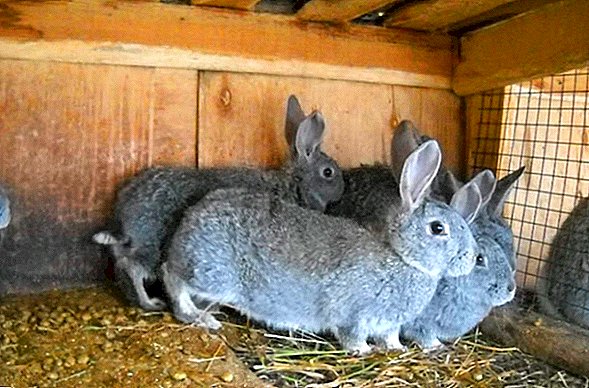
- Feeders are often loaded once every 3-4 days, but if necessary, provide food for rabbits for 7-8 days. Before each loading of the feed, the feeder is cleaned, if possible, from the remnants of old food.
- In the summer, in most cases, the drinkers in the sheds are filled automatically, in the winter they are filled by hand - for this they use clean, slightly heated water.
- Before the appearance of the young, the Sheds are disinfected. To do this, the animals are transplanted in a separate place, and the entire contents of the rabbit is thoroughly cleaned and treated with 4% formalin solution or 3% copper sulfate solution.
Important! In cold northern climates, the sheds must be provided with a heating system, otherwise rabbits may get sick.
After processing, residual liquids are rinsed with clean tap water. Whenever possible, incombustible structural elements and internal objects are fired with a blowtorch.
Outdoor cell
The outer-cell system for keeping fur-bearing animals is the direct predecessor of the shed. In small cages, animals were actively divorced many decades ago, but even today such systems are no less popular.
Read more about how to score a rabbit, as well as how to make a rabbit skin.
Often they are used for breeding rabbits in small livestock farms or private backyards. Such designs are made of wood or metal.
External cells are of two types:
- individual - used for the maintenance of individual individuals;
- group - used for the mass rearing of rabbits, in most cases provide for the resettlement of animals by gender, but sometimes males and females are kept together.

Cells often consist of several compartments. Their design includes a breeding area, a drinking bowl and a feeder for the main feed, separated by a mesh barrier, as well as a feeder for roughage - it is mounted on the outside of the cage and has a small outlet for collecting food. The entire structure is installed on a height of 1 m from the level of the soil permanently, but in some cases removable cells are provided.
Such constructions are quite effective, as they protect animals from all kinds of adverse environmental factors. Strong walls protect animals from excessive drafts and wind, while achieving good ventilation and a natural moisture regime, which is important enough to maintain the general health of animals.
The temperature in the outer cells in the cold season is 2-3 ° C higher than in the open air, and 2-3 ° C lower in the summer. This helps to maintain optimal microclimate indicators at almost any time of the year, as well as to protect animals from direct sunlight.  The cages also provide the animals with a natural day length, which helps to adjust to their mode and rabbit host.
The cages also provide the animals with a natural day length, which helps to adjust to their mode and rabbit host.
Find out at what age rabbits molt and how to care for them, what affects life expectancy and how long rabbits live on average, as well as what to do with sun and heat stroke in rabbits, finding fleas in rabbits and sneezing a rabbit.
Caring for this design requires daily:
- Each animal must be provided with an optimal amount of feed and drinking water.
- You also need to daily eliminate feces and all sorts of food residues.
- In winter, the cells are warmed with hay or straw, so animals are often kept on the street all year round. In the conditions of the northern climate, the structures are transferred to heated premises.
- Before okolom conduct mandatory sterilization of the cell with a 4% formalin solution or 3% solution of blue vitriol. During this, the animals are transplanted into temporary premises.

Despite its simplicity, the outer-cell system makes it possible for animals to provide individual care. In this case, it is possible to carry out thorough breeding work, as well as to obtain high-quality animal products. That is why such constructions are often used on large farms for breeding breeds.
Did you know? The duration of life in domestic rabbits is about 9 years, while their wild relatives live no more than 1-2 years.
Indoors
Closed rabbitries are the most optimal designs for active breeding of fur-bearing animals. Only they give the opportunity to fully protect the animal from adverse environmental conditions. Such constructions are made of metal or reinforced concrete.  Indoors animals can be kept both in individual cages, and in small groups behind the fence. Such constructions are used mainly by large-scale farms for mass breeding of rabbits, but sometimes they can also be seen in private rabbit breeders.
Indoors animals can be kept both in individual cages, and in small groups behind the fence. Such constructions are used mainly by large-scale farms for mass breeding of rabbits, but sometimes they can also be seen in private rabbit breeders.
Indoors it is possible to create ideal conditions for the growth and reproduction of rabbits. First of all, it is the average daily temperature of about + 12-18 ° C and relative humidity of about 60-70%, as well as the absence of drafts, sudden changes in temperature and direct solar radiation.
Indoor lighting is often artificial, so for rabbits an optimal daylight mode is created (8-10 hours). Enclosed spaces are often equipped with artificial heating, ventilation, individual water and feed supply systems, as well as drainage for faeces. In the absence of their care of the premises is carried out manually.  For this:
For this:
- It should be at least 1 time a day to fill the feeders, as well as to replace drinking water.
- During the off-season, indoor humidity control is required using air vents or an automatic system.
- The removal of feces is carried out daily. For this purpose, a shovel and a special scraper carry out a thorough cleaning of manure drains. If the system does not provide sewage, feces should be removed 2 times a day, morning and evening.
- Before the appearance of young stock the premises are disinfected. For this, the rabbitrel is thoroughly cleaned of any excrement and other residues, and then treated with 4% formalin solution or 3% copper sulfate solution. Whenever possible, non-combustible objects of the room, as well as walls and the floor are burned with a direct flame.
Equipment and inventory
For the care of rabbits often used a standard set of equipment and inventory, so you can buy it in almost any hardware store. The main thing is to pay attention to its quality, since poor-quality products can cause injuries to the animal and quite serious losses.
Cells
The cage is often made of wood, plywood or metal, or a combination of these materials. The most optimal are metal structures made of a durable steel frame and metal mesh.
Did you know? The female rabbit is capable of carrying 2 litters from different males at the same time: this is due to the forked nature of the uterus.
They are more resistant to a variety of aggressive substances and high humidity than wood. If they are not available, cells made of a wooden frame lined with metal mesh can be used. Caring for the cell daily, but in the absence of free time, the number of cleanings is reduced to 1 in 2-3 days.  During cleaning for the convenience of animals transplanted into temporary houses. At this time, feces, old litter and other contaminants are removed from the cell. General cleaning is carried out 1 time per month. First, the cleaning is carried out mechanically, using brushes, scrapers and small blades or spatulas. After that, its outer and inner parts are washed with soapy water.
During cleaning for the convenience of animals transplanted into temporary houses. At this time, feces, old litter and other contaminants are removed from the cell. General cleaning is carried out 1 time per month. First, the cleaning is carried out mechanically, using brushes, scrapers and small blades or spatulas. After that, its outer and inner parts are washed with soapy water.
Important! The bottom of the cage must necessarily be made of a flat monolithic shield. Net bottom can cause damage to the paws of the animal and subsequent infectious lesions of the outer covers of the limbs.
Before the appearance of young stock, the cage is disinfected with the above solutions, and also burned, if possible. During infectious diseases, the cell is disinfected unplanned: during the active development of the disease and after complete convalescence of the animals. 
Feeders
On the market there are many varieties of feeders for rabbits, among them there are both universal and specific models. Most often in the cells equip 2 types of containers for food, nursery and cup type. Bowl feeders have the form of a small deep vessel in which grain or succulent food is poured.
Learn how to make cages, feeders and drinkers for rabbits.
Most often, such models are made of metal or plastic. Predatory feeders are mounted outside the cage near the specially equipped opening, they poured dry grass or hay. Such feeders are made of wood or thin sheet metal.
The most preferred when the content of rabbits are considered universal tanks for feed. These are so-called flutes or bunker models. In their form, they resemble a gutter and are made of thin sheet metal. Such feeders are suitable for any kind of feed.  Feeders require minimal maintenance. Most farmers clean them every time they change food, but for convenience, this procedure can be done 2-3 times a week. Clean the feeders from the remnants with special brushes and spatulas, after which they are thoroughly rinsed under running water. Once a month, feed containers are subjected to general cleaning and sterilization (along with the entire cage).
Feeders require minimal maintenance. Most farmers clean them every time they change food, but for convenience, this procedure can be done 2-3 times a week. Clean the feeders from the remnants with special brushes and spatulas, after which they are thoroughly rinsed under running water. Once a month, feed containers are subjected to general cleaning and sterilization (along with the entire cage).
We advise you to read about what you can not feed rabbits, what they eat and how to feed rabbits in winter, what grass to feed rabbits, and whether rabbits eat wormwood, nettles and burdocks.
Drinking bowls
Drinkers for rabbits are vacuum and nipple. Vacuum containers are small open pan containers with a tank immersed in them. After the rabbit drinks water, there is a pressure difference between the tank and the tank, due to which the cup is refilled with water.  Nipple are a sealed reservoir from which the tube with the nipple at the end departs. After pressing the nipple, the tube opens and water flows out slowly. A nipple drinker is preferable, since such containers are more hygienic.
Nipple are a sealed reservoir from which the tube with the nipple at the end departs. After pressing the nipple, the tube opens and water flows out slowly. A nipple drinker is preferable, since such containers are more hygienic.
Care of the drinker is not difficult:
- Water is changed daily in it - it helps to avoid the development of pathogenic bacteria in the tank.
- After removing the dirty water, the drinker must be rinsed under clean running water to avoid gastrointestinal upset in rabbits.
- 1-2 times a month, the drinker is cleaned with soap solutions and disinfected with the above means.
It will be useful for you to read about how to water the rabbits with water.
Nest boxes
Nest boxes in the rabbit are set 3-5 days before the estimated date of birth of the offspring. They are made of plywood or polished wooden planks, the flooring of straw is laid on the bottom of the box.  Often the breeding box does not require special attention, since the rabbit is able to provide her offspring with the necessary care. The only nest care measure is to replace the dirty litter periodically (once a week). After the cubs become independent (5-8 weeks after birth), the nest box is dismantled.
Often the breeding box does not require special attention, since the rabbit is able to provide her offspring with the necessary care. The only nest care measure is to replace the dirty litter periodically (once a week). After the cubs become independent (5-8 weeks after birth), the nest box is dismantled.
Feed preparation facilities
Preliminary preparation of feed is carried out with the help of various secateurs. With their help, it is possible to grind any food, including various root crops and herbs. They represent a conveyor on which rotating elements with knives are mounted.
When the conveyor moves under the influence of knives, the feed is crushed and then released into the storage tank. Today there are automatic and mechanical models.  Mechanical are more often used by small farms, since at low cost they allow to get high-quality ground feed. Automatic pruners of various capacities are used on large or medium-sized farms. Such devices are much more expensive than mechanical ones, however, they can very quickly provide a large number of rabbits with crushed feed.
Mechanical are more often used by small farms, since at low cost they allow to get high-quality ground feed. Automatic pruners of various capacities are used on large or medium-sized farms. Such devices are much more expensive than mechanical ones, however, they can very quickly provide a large number of rabbits with crushed feed.
The most common care for such devices is to clean the remnants of food every day. Automatic models are regularly checked for serviceability, at least 1 time per month. Periodically, the secateurs are disinfected (1 time per month) in order to avoid the development of infectious ailments in the rabbit.
Wool cleaning
In most cases, all sorts of rabbit breeds do not require the care of their coat. These animals are sensitive to their appearance and are able to care for their own cleanliness and the condition of the upper integument. Therefore, these animals are bathed in exceptional cases, after excessive contamination.  Use for this purpose specially developed shampoos for animals. If necessary, also combing rabbits. Do this with brushes and hairbrushes for the fur of fur animals, and only in the case of excessively active molting.
Use for this purpose specially developed shampoos for animals. If necessary, also combing rabbits. Do this with brushes and hairbrushes for the fur of fur animals, and only in the case of excessively active molting.
Important! Water procedures with cosmetics intended for humans are strictly prohibited to rabbits: they can cause severe irritation of the skin and even lead to hair loss.
The norms of the content at the age and rearing of the young
Around the rabbit lasts for 10-25 minutes. В это время ей нужно обеспечить условия для благополучного завершения процесса. Прежде всего это уют, покой, отсутствие резких запахов и громких звуков, а также сумрачный, рассеянный свет.Immediately after birth, the offspring must be checked for all sorts of pathologies and viability.  For this rabbit is lured out of the nest and moved to a separate cage. The rabbit should also be examined, especially after the first birth, which are often difficult for the young to carry. Further examination of the newborn young is carried out daily, this will help save the weak cubs from death.
For this rabbit is lured out of the nest and moved to a separate cage. The rabbit should also be examined, especially after the first birth, which are often difficult for the young to carry. Further examination of the newborn young is carried out daily, this will help save the weak cubs from death.
We recommend to read about when you can set aside rabbits from the rabbit, as well as what and how to feed the rabbits without the rabbit.
The optimal condition for the successful development of a baby rabbit is an average temperature of about + 38 ° C. Often, the heat of the mother is sufficient to provide the offspring with the necessary microclimate, but if the birth takes place in winter, the rabbitcher should be equipped with an additional source of heat, or an infrared heater installed in the cage.
Newborn offspring is highly susceptible to stress, so the nest box with the cage should be installed in a quiet and protected from excessive noise and sharp odors place. The first 14-20 days of breeding offspring is engaged exclusively rabbit, so she should definitely provide enhanced vitamin nutrition.  Approximately at 2 weeks her lactation decreases, therefore at this moment the young growth tries adult food for the first time: for this, the cage is settled down with a separate feeder for small rabbits. Their first food is finely chopped vegetables, fruits and greens.
Approximately at 2 weeks her lactation decreases, therefore at this moment the young growth tries adult food for the first time: for this, the cage is settled down with a separate feeder for small rabbits. Their first food is finely chopped vegetables, fruits and greens.
After 20-25 days after birth, the rabbits are ready for consumption of dry and concentrated feed, which should also be provided with a feed. Approximately 1-1.5 months after birth, the rabbit ends in lactation - from this moment the rabbits become adults, so they are separated into separate cages. In the future, young animals are cared for as well as mature individuals.
Personal hygiene at work
The main recommendations for personal hygiene when working in the rabbit:
- personnel are allowed to work with animals without any infectious diseases transmitted from person to animal;
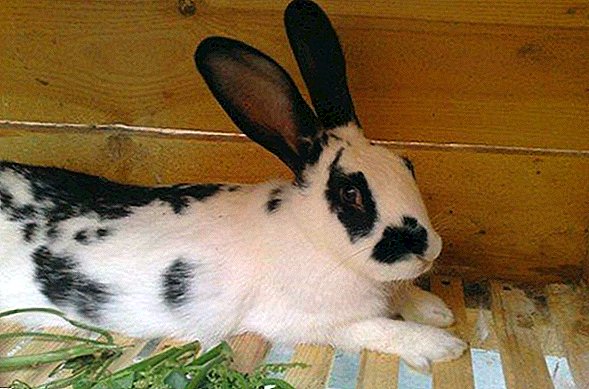
- All work should be carried out in special equipment, including a clean, replaceable top coat (robe), as well as clean rubber boots and work gloves;
- before working with animals to use the perfume is prohibited;
- workers with alcoholic or narcotic intoxication are not allowed to animals;
- it is forbidden to smoke, drink and eat food while working in the rabbit;
- after work, hands, as well as open areas of the body should be thoroughly washed with soapy water;
- If among animals there are individuals with infectious diseases, hands and exposed areas of the body must be disinfected with 70% ethyl alcohol or 3% potassium permanganate solution.
Proper and careful observance of the rules for the care of rabbits is the main condition for the safe rearing of these animals, as well as obtaining high-quality animal products.  To do this, acquire the necessary inventory and control the microclimate and general hygienic conditions in the rabbit. Only in this case, rabbit breeding will become not only successful, but also a fairly profitable type of activity.
To do this, acquire the necessary inventory and control the microclimate and general hygienic conditions in the rabbit. Only in this case, rabbit breeding will become not only successful, but also a fairly profitable type of activity.



